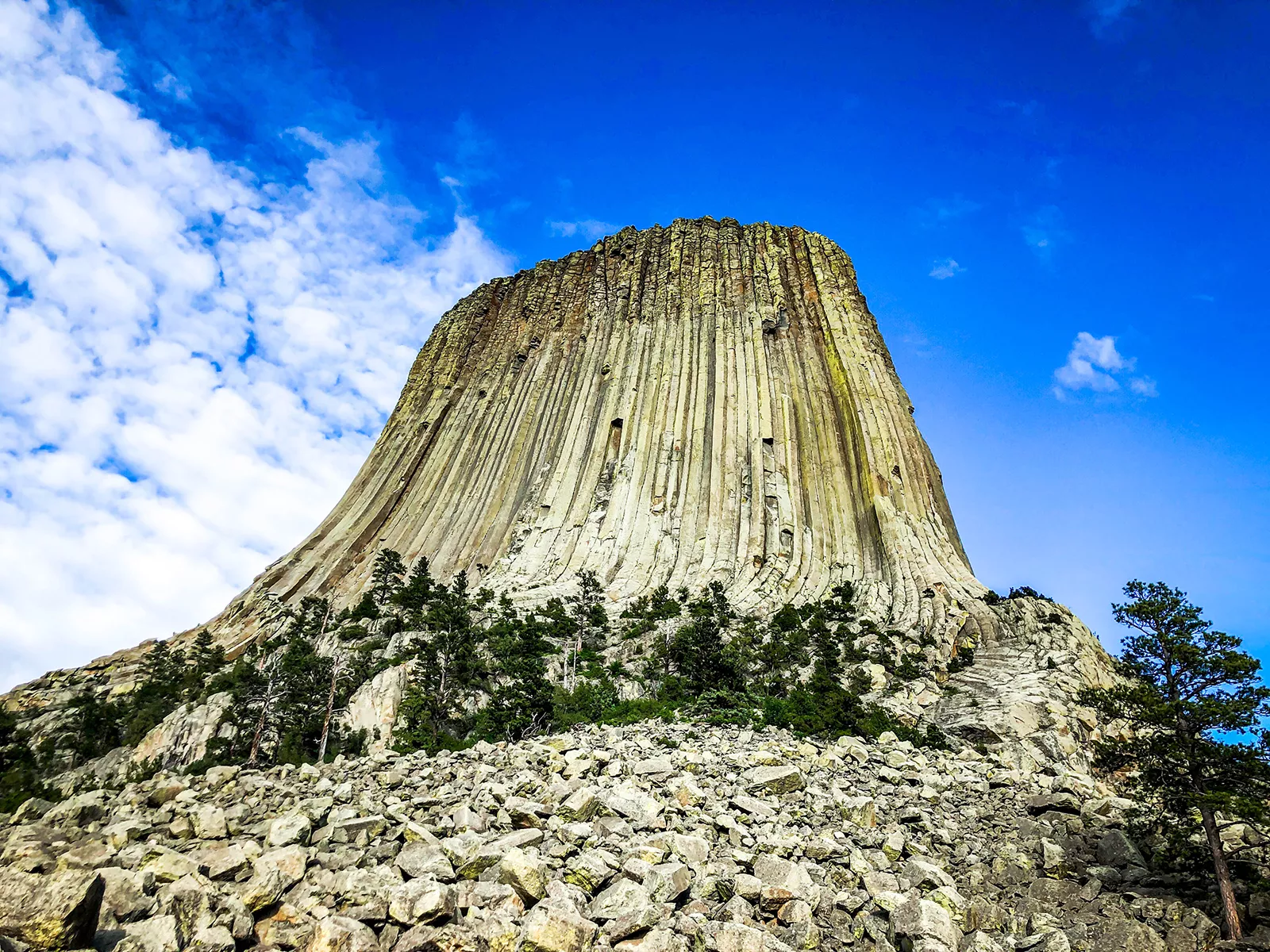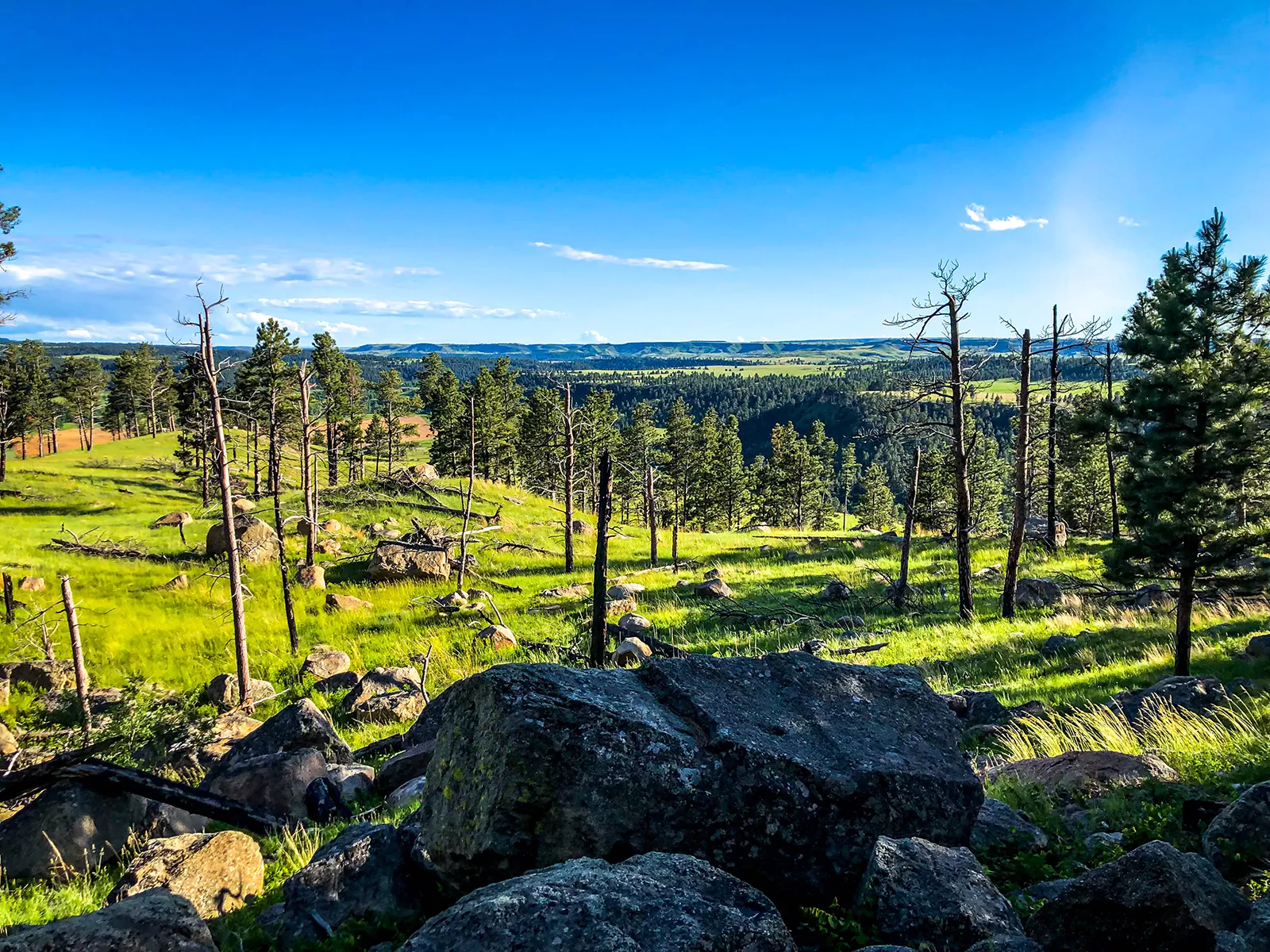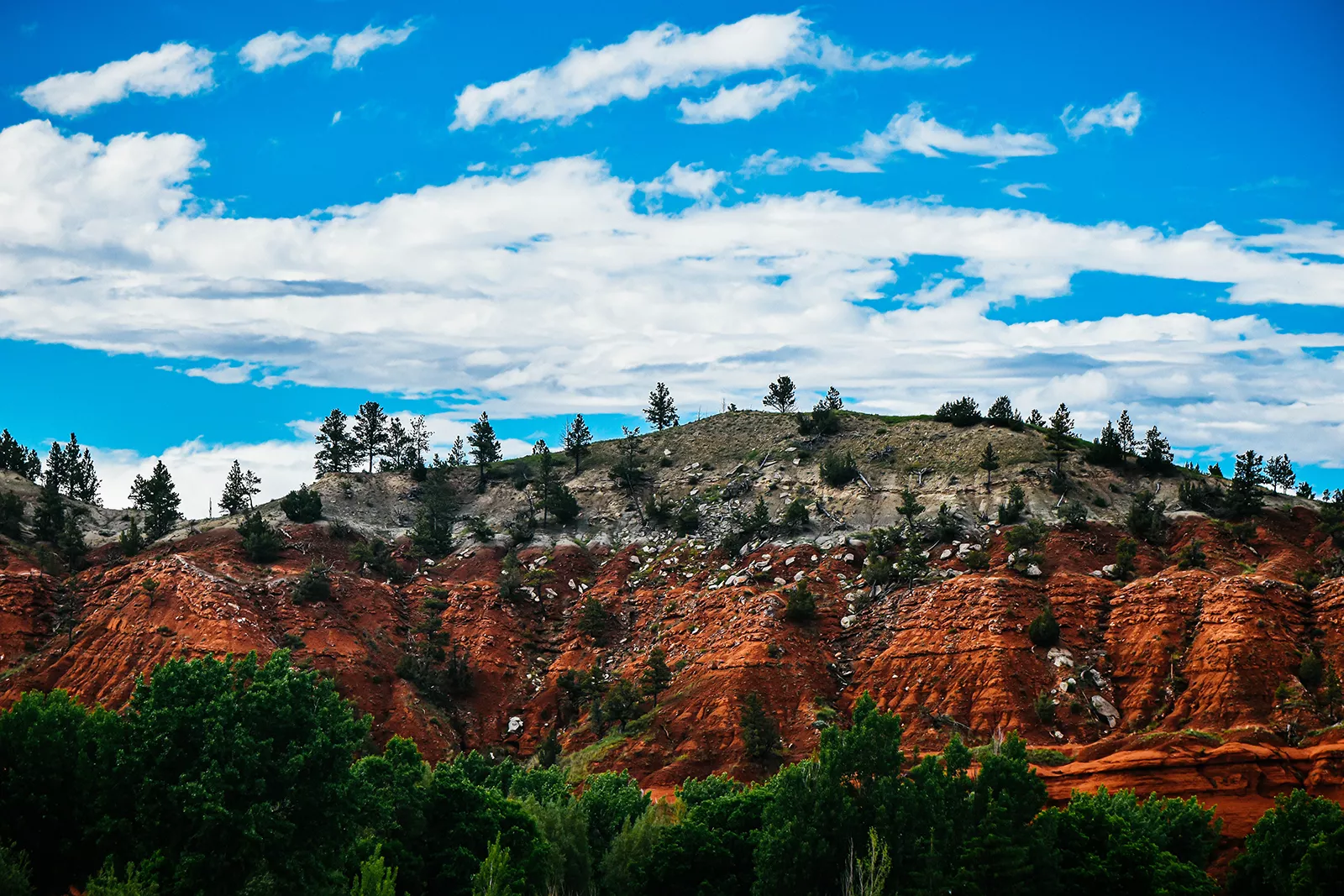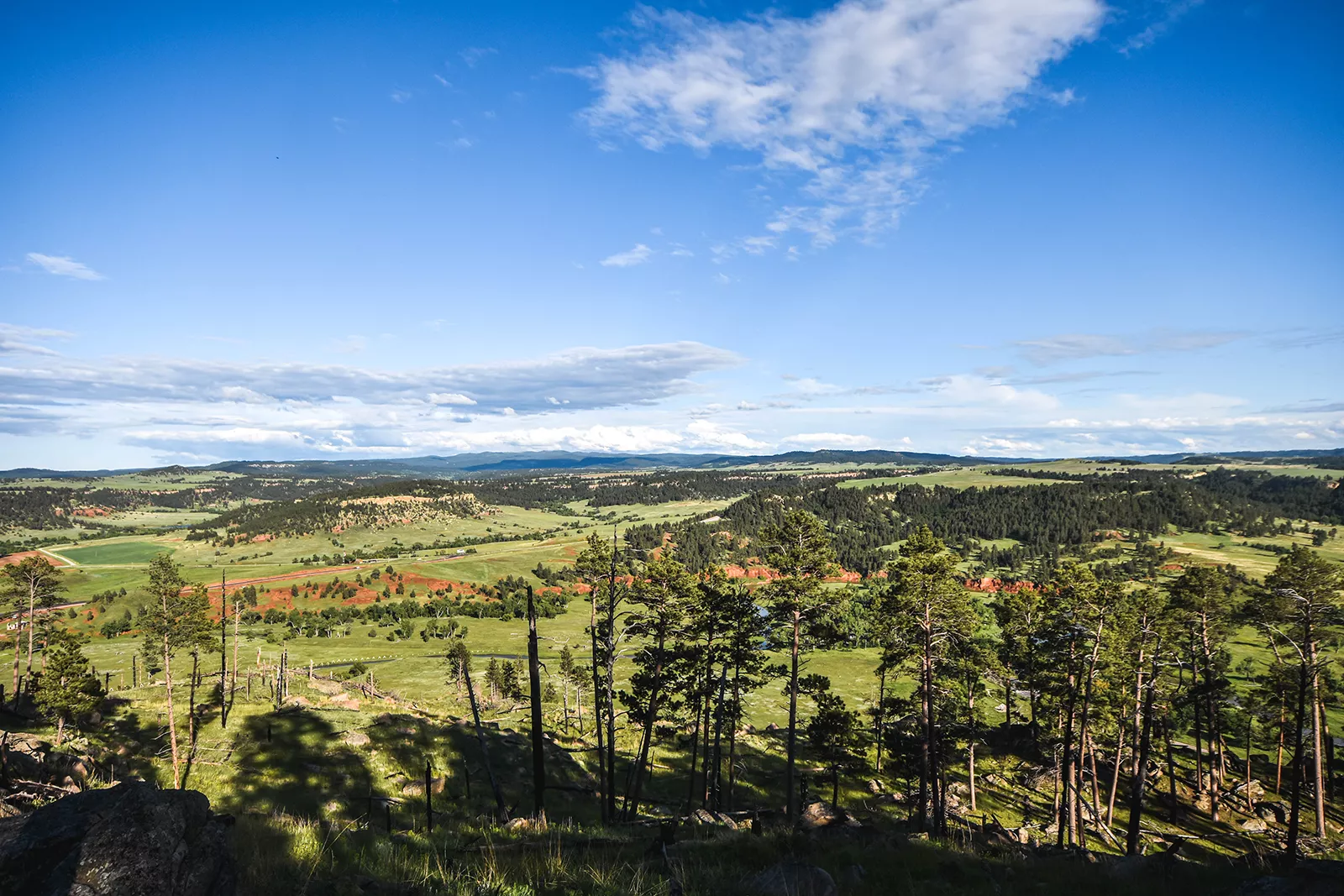Devils Tower National Monument: Exploring America’s First National Monument
Nestled in the northeastern corner of Wyoming, rising like a formidable sentinel from the rolling prairies, stands Devils Tower National Monument, an awe-inspiring geological feature that dominates the landscape. This magnificent butte, known as “Bear Lodge” by the Northern Plains Tribes, holds a special place in American history and culture. Designated as America’s first national monument by President Theodore Roosevelt in 1906, Devils Tower has since been a beacon for nature lovers, climbers, and those intrigued by its rich Native American heritage. This article will guide you through the wonders of Devils Tower, blending its geological uniqueness, historical significance, and cultural importance, with practical tips for making the most of your visit.
A dark mist lay over the Black Hills, and the land was like iron. At the top of the ridge I caught sight of Devil’s Tower upthrust against the gray sky as if in the birth of time the core of the earth had broken through its crust and the motion of the world was begun. – N. SCOTT MOMADAY, AUTHOR
Devils Tower, standing at an impressive 867 feet from its base to the summit, is a geological marvel. It is a rare igneous formation, known as a phonolite porphyry, characterized by its striking columnar joints. These columns, mostly hexagonal in shape, were formed by the slow cooling of molten magma. The surrounding softer sedimentary rocks have eroded away over millions of years, leaving the tower standing alone against the horizon. The result is a jaw-dropping, almost otherworldly structure that captivates geologists and tourists alike.
For many Native American tribes, including the Lakota, Cheyenne, and Kiowa, Devils Tower is a sacred site. Each tribe has its own legends and spiritual beliefs associated with the Tower. A common theme in these stories is that of a giant bear, which left claw marks on the sides of the rock formation while pursuing spiritual figures or heroes. These narratives are not just tales of the past but are integral to the living cultures and spiritual practices of these tribes. Visitors are encouraged to respect the site’s sacredness, especially during the month of June, when many tribes conduct ceremonies around the monument.
For the adventurous, Devils Tower offers an unparalleled climbing experience. With hundreds of established climbing routes, like the popular “Durrance Route” or the challenging “El Matador,” the monument attracts climbers from around the world. However, climbing here is not for the faint-hearted and requires experience and proper equipment. The National Park Service provides climbing guidelines and asks climbers to voluntarily refrain from climbing during June out of respect for Native American ceremonies.
At Devils Tower National Monument, the interplay of unique geological structures and diverse ecosystems creates a sanctuary for a wide range of wildlife and plant life, painting a vibrant portrait of northeastern Wyoming’s natural world.
The monument’s fauna is as varied as it is fascinating. Among the most visible are the prairie dogs, particularly populous in the large prairie dog town near the park’s entrance. These social animals offer an intriguing glimpse into complex animal societies. The park’s larger mammalian inhabitants include white-tailed and mule deer, often sighted in the quieter hours of dawn and dusk. Alongside these, more elusive creatures such as porcupines, foxes, and occasional bobcats maintain a discreet presence.

Bird life in the park is abundant and varied, making Devils Tower a prime spot for bird watching. Raptors like red-tailed hawks and golden eagles are often seen gracefully soaring around the tower, utilizing the thermals for lift. The park’s forests and grasslands are also home to a chorus of songbirds, with the Western Meadowlark‘s melody being a common and delightful background sound. Woodpeckers and nuthatches add to the avian diversity, especially in wooded areas and along water sources.
Reptiles and amphibians, though less noticeable, play their part in the park’s ecosystem. Snakes such as the non-venomous bull snake, along with various lizards and toads, are found throughout the park, particularly in warmer months.
The flora of Devils Tower is as diverse as its fauna. The park’s landscape includes pine forests and woodlands, where ponderosa pine dominates, interspersed with patches of bur oak and aspen. These wooded areas not only add to the scenic beauty but also provide essential habitats for wildlife. The surrounding rolling prairies are part of the mixed-grass prairie ecosystem, featuring grass species like blue grama, buffalo grass, and western wheatgrass, all adapted to the semi-arid climate. In spring and summer, these grasslands are a spectacle of colors with wildflowers such as the prairie rose in full bloom. Additionally, riparian habitats along the Belle Fourche River and other streams in the park support a different set of plant species, including willows and cottonwoods, crucial for maintaining biodiversity and offering a lush contrast to the drier grasslands.

The ecosystem at Devils Tower National Monument represents a harmonious and intricate web of life, where each species, from the humble prairie dog to the majestic ponderosa pine, plays a significant role in the ecological community. For visitors, the monument offers a rich and varied experience in observing and appreciating the interconnectedness of the natural world.
The visitor center at Devils Tower provides extensive information about the monument’s geology, history, and cultural significance. It’s an excellent starting point for your visit, offering guided tours, interpretive programs, and educational exhibits. For accommodations, the monument has a campground with sites available on a first-come, first-served basis, and there are numerous lodging options in the nearby towns.

Devils Tower National Monument is a stunning natural wonder; it’s a place where the Earth’s geological history merges with rich cultural traditions and where adventure and tranquility coexist. Whether you’re a climber seeking a challenging ascent, a nature enthusiast exploring trails, or someone fascinated by the cultural stories surrounding this unique monument, Devils Tower promises an unforgettable experience. As you stand beneath the towering columns and gaze upwards, you’re not just seeing a remarkable geological formation; you’re witnessing a symbol of America’s diverse natural and cultural heritage.
Devils Tower National Monument Trails
Devils Tower National Monument, a spectacular geological formation in northeastern Wyoming, offers a range of hiking experiences that allow visitors to immerse themselves in its natural beauty and cultural significance. The monument boasts several trails, each with its own unique features and varying levels of difficulty.
The Devils Tower Trail is perhaps the most popular hiking path in the monument, largely due to its proximity to the iconic tower itself. This 1.3-mile loop is relatively flat and well-maintained, making it accessible for hikers of all skill levels. As you meander around the base of the tower, you are treated to an evolving view of its massive columns, which seem to change in appearance with every step. Along the path, interpretive signs provide insights into the geological and cultural history of the area, enriching your understanding of this magnificent landscape. The trail also offers occasional glimpses of the Belle Fourche River Valley, enhancing the scenic experience with diverse wildlife sightings.
In contrast to the up-close perspective of Devils Tower Trail, the Red Beds Trail offers a broader view of the monument and its surroundings. This 2.8-mile loop is named for the vivid red clay and siltstone that characterize its path, providing a striking visual contrast to the gray of Devils Tower. The trail is moderately challenging, with some elevation changes and steeper sections, making it an excellent choice for those seeking a bit more adventure. As you loop around the tower, you’ll enjoy panoramic views of the Black Hills and the high plains, a landscape rich in geological history and biodiversity. The Red Beds Trail is less frequented than the Devils Tower Trail, offering a peaceful hiking experience away from the crowds.

For those in search of tranquility, the Joyner Ridge Trail is a perfect choice. This 1.5-mile trail is less traveled, offering a serene escape into the natural world. As you traverse through grasslands and pine forests, the trail provides a varied backdrop to your hike. The Joyner Ridge Trail is relatively easy, though it includes some undulating terrain that adds a slight challenge. One of the highlights of this trail is the unique vantage point it offers of Devils Tower, presenting the monolith in a different light, especially stunning during sunrise or sunset.
When hiking at Devils Tower, it’s important to come prepared. Carrying water, snacks, sunscreen, and a basic first-aid kit is essential, even for shorter hikes. The weather can be unpredictable, so dressing in layers is advisable. As you encounter wildlife, such as the abundant prairie dogs, remember to keep a safe distance and refrain from feeding them. Staying on designated trails is crucial to protect the fragile ecosystem of the area. Additionally, given the cultural importance of Devils Tower to many Native American tribes, hikers should be respectful of any cultural artifacts or ceremonies they may encounter. The best times for hiking are early morning or late afternoon to avoid the heat and crowds.
What’s Nearby Devils Tower National Monument
Just a stone’s throw away from Devils Tower National Monument are other marvels of the American landscape, each offering its unique natural beauty and adventure. Wind Cave National Park, renowned for one of the world’s longest and most complex caves, showcases intricate cave formations alongside a rich prairie landscape above ground, where bison and elk roam freely. Further east, the Badlands National Park presents a striking landscape of eroded buttes, pinnacles, and spires, blended with the largest undisturbed mixed grass prairie in the United States. This dramatic topography serves as a backdrop to a diverse range of wildlife and a vast fossil bed. Venturing westward, you’ll find Grand Teton National Park, a spectacular destination with its iconic, jagged peaks that rise abruptly from the Jackson Hole valley, offering breathtaking hiking trails, pristine lakes, and abundant wildlife including moose, bears, and eagles. Finally, no journey through this region would be complete without a visit to Yellowstone National Park, the first national park in the world, famous for its geothermal wonders like the Old Faithful geyser and the Grand Prismatic Spring, as well as its vast wilderness, home to grizzly bears, wolves, and herds of bison and elk. Each of these parks, in close proximity to Devils Tower, provides a unique window into the diverse natural beauty and ecological wonders of the American West.
Devils Tower National Monument Parking Information
Parking at Devils Tower National Monument is an aspect that visitors should plan for to ensure a smooth and enjoyable experience. The monument features a main parking area located near the visitor center, which serves as the central hub for those looking to explore the trails, participate in ranger-led programs, or simply soak in the views of the tower. This parking lot is designed to accommodate a significant number of vehicles, including larger ones like RVs and buses, making it accessible for all types of visitors.
During peak tourist seasons, typically from late spring to early fall, the parking area can become quite busy, especially during midday. To avoid the crowds and ensure a spot, it’s advisable to arrive early in the morning or later in the afternoon. This timing also coincides with cooler temperatures and better wildlife viewing opportunities.



